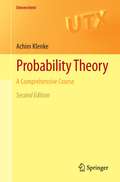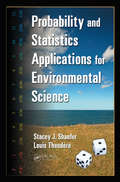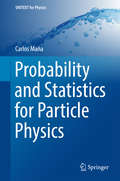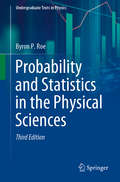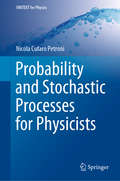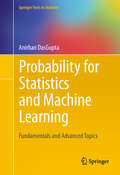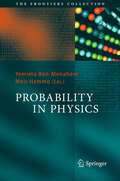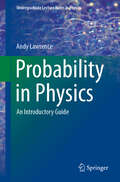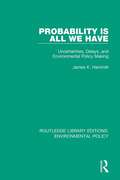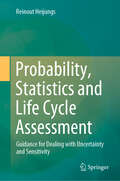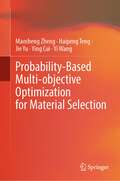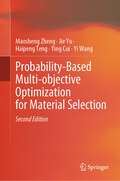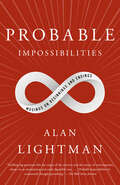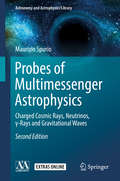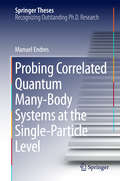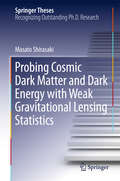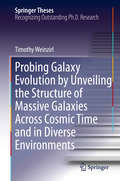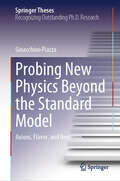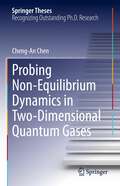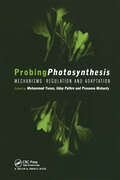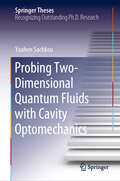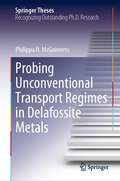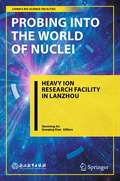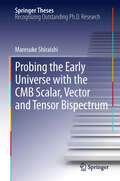- Table View
- List View
Probability Theory: A Comprehensive Course
by Achim KlenkeThis second edition of the popular textbook contains a comprehensive course in modern probability theory. Overall, probabilistic concepts play an increasingly important role in mathematics, physics, biology, financial engineering and computer science. They help us in understanding magnetism, amorphous media, genetic diversity and the perils of random developments at financial markets, and they guide us in constructing more efficient algorithms. To address these concepts, the title covers a wide variety of topics, many of which are not usually found in introductory textbooks, such as: * limit theorems for sums of random variables * martingales * percolation * Markov chains and electrical networks * construction of stochastic processes * Poisson point process and infinite divisibility * large deviation principles and statistical physics * Brownian motion * stochastic integral and stochastic differential equations. The theory is developed rigorously and in a self-contained way, with the chapters on measure theory interlaced with the probabilistic chapters in order to display the power of the abstract concepts in probability theory. This second edition has been carefully extended and includes many new features. It contains updated figures (over 50), computer simulations and some difficult proofs have been made more accessible. A wealth of examples and more than 270 exercises as well as biographic details of key mathematicians support and enliven the presentation. It will be of use to students and researchers in mathematics and statistics in physics, computer science, economics and biology.
Probability and Evidence
by Paul HorwichIn this volume, which was originally published in 1982, Paul Horwich presents a clear and unified approach to a number of problems in the philosophy of science. He diagnoses the failure of other attempts to resolve them as stemming from a too-rigid, all-or-nothing conception of belief, and adopts instead a Bayesian strategy, emphasising the degree of confidence to which we are entitled the light of scientific evidence. This probabilistic approach, he argues, yields a more complete understanding of the assumptions and procedures characteristic of scientific reasoning. It also accounts for the merits of simplicity, severe tests and surprising predictions, and provides a way in which the dispute between the realist and instrumentalist views of science might be resolved. The result is a crisp, well-focused contribution to the philosophy of science. The elaboration of an important conception of probability will stimulate anyone with an interest in the field.
Probability and Statistics Applications for Environmental Science
by Louis Theodore Stacey J ShaeferSimple, clear, and to the point, Probability and Statistics Applications for Environmental Science delineates the fundamentals of statistics, imparting a basic understanding of the theory and mechanics of the calculations. User-friendliness, uncomplicated explanations, and coverage of example applications in the environmental field set this book ap
Probability and Statistics for Particle Physics
by Carlos MañaThis book comprehensively presents the basic concepts of probability and Bayesian inference with sufficient generality to make them applicable to current problems in scientific research. The first chapter provides the fundamentals of probability theory that are essential for the analysis of random phenomena. The second chapter includes a full and pragmatic review of the Bayesian methods that constitute a natural and coherent framework with enough freedom to analyze all the information available from experimental data in a conceptually simple manner. The third chapter presents the basic Monte Carlo techniques used in scientific research, allowing a large variety of problems to be handled difficult to tackle by other procedures. The author also introduces a basic algorithm, which enables readers to simulate samples from simple distribution, and describes useful cases for researchers in particle physics.The final chapter is devoted to the basic ideas of Information Theory, which are important in the Bayesian methodology. This highly readable book is appropriate for graduate-level courses, while at the same time being useful for scientific researches in general and for physicists in particular since most of the examples are from the field of Particle Physics.
Probability and Statistics in the Physical Sciences (Undergraduate Texts in Physics)
by Byron P. RoeThis book, now in its third edition, offers a practical guide to the use of probability and statistics in experimental physics that is of value for both advanced undergraduates and graduate students. Focusing on applications and theorems and techniques actually used in experimental research, it includes worked problems with solutions, as well as homework exercises to aid understanding. Suitable for readers with no prior knowledge of statistical techniques, the book comprehensively discusses the topic and features a number of interesting and amusing applications that are often neglected. Providing an introduction to neural net techniques that encompasses deep learning, adversarial neural networks, and boosted decision trees, this new edition includes updated chapters with, for example, additions relating to generating and characteristic functions, Bayes’ theorem, the Feldman-Cousins method, Lagrange multipliers for constraints, estimation of likelihood ratios, and unfolding problems.
Probability and Stochastic Processes for Physicists (UNITEXT for Physics)
by Nicola Cufaro PetroniThis book seeks to bridge the gap between the parlance, the models, and even the notations used by physicists and those used by mathematicians when it comes to the topic of probability and stochastic processes. The opening four chapters elucidate the basic concepts of probability, including probability spaces and measures, random variables, and limit theorems. Here, the focus is mainly on models and ideas rather than the mathematical tools. The discussion of limit theorems serves as a gateway to extensive coverage of the theory of stochastic processes, including, for example, stationarity and ergodicity, Poisson and Wiener processes and their trajectories, other Markov processes, jump-diffusion processes, stochastic calculus, and stochastic differential equations. All these conceptual tools then converge in a dynamical theory of Brownian motion that compares the Einstein–Smoluchowski and Ornstein–Uhlenbeck approaches, highlighting the most important ideas that finally led to a connection between the Schrödinger equation and diffusion processes along the lines of Nelson’s stochastic mechanics. A series of appendices cover particular details and calculations, and offer concise treatments of particular thought-provoking topics.
Probability for Statistics and Machine Learning
by Anirban DasguptaThis book provides a versatile and lucid treatment of classic as well as modern probability theory, while integrating them with core topics in statistical theory and also some key tools in machine learning. It is written in an extremely accessible style, with elaborate motivating discussions and numerous worked out examples and exercises. The book has 20 chapters on a wide range of topics, 423 worked out examples, and 808 exercises. It is unique in its unification of probability and statistics, its coverage and its superb exercise sets, detailed bibliography, and in its substantive treatment of many topics of current importance. This book can be used as a text for a year long graduate course in statistics, computer science, or mathematics, for self-study, and as an invaluable research reference on probabiliity and its applications. Particularly worth mentioning are the treatments of distribution theory, asymptotics, simulation and Markov Chain Monte Carlo, Markov chains and martingales, Gaussian processes, VC theory, probability metrics, large deviations, bootstrap, the EM algorithm, confidence intervals, maximum likelihood and Bayes estimates, exponential families, kernels, and Hilbert spaces, and a self contained complete review of univariate probability.
Probability in Physics
by Meir Hemmo Yemima Ben-MenahemWhat is the role and meaning of probability in physical theory, in particular in two of the most successful theories of our age, quantum physics and statistical mechanics? Laws once conceived as universal and deterministic, such as Newton's laws of motion, or the second law of thermodynamics, are replaced in these theories by inherently probabilistic laws. This collection of essays by some of the world's foremost experts presents an in-depth analysis of the meaning of probability in contemporary physics. Among the questions addressed are: How are probabilities defined? Are they objective or subjective? What is their explanatory value? What are the differences between quantum and classical probabilities? The result is an informative and thought-provoking book for the scientifically inquisitive.
Probability in Physics: An Introductory Guide (Undergraduate Lecture Notes in Physics)
by Andy LawrenceThis textbook presents an introduction to the use of probability in physics, treating introductory ideas of both statistical physics and of statistical inference, as well the importance of probability in information theory, quantum mechanics, and stochastic processes, in a unified manner. The book also presents a harmonised view of frequentist and Bayesian approaches to inference, emphasising their complementary value. The aim is to steer a middle course between the "cookbook" style and an overly dry mathematical statistics style. The treatment is driven by real physics examples throughout, but developed with a level of mathematical clarity and rigour appropriate to mid-career physics undergraduates. Exercises and solutions are included.
Probability is All We Have: Uncertainties, Delays, and Environmental Policy Making (Routledge Library Editions: Environmental Policy #10)
by James K. HammittFirst published in 1990. In this study, the author suggests ways that policy-makers can think about environmental policy choice that responds to the importance of uncertainty and delay. Hammitt describes several tools for environmental policy analysis and illustrates their application to important policy issues. In the first part of the book, dealing with stratospheric-ozone depletion, the author describes techniques for accommodating outcome uncertainties. The second part of the study considers the health risks associated with pesticide residues on food. The final section addresses the issue of potential global climate change, and describes how the tools explored can be applied to this new challenge. This book should be of greatest interest to academic, government, and industry analysts and others concerned with improving methods for environmental-policy making.
Probability, Statistics and Life Cycle Assessment: Guidance for Dealing with Uncertainty and Sensitivity
by Reinout HeijungsThis textbook discusses the use of uncertainty analysis and sensitivity analysis in environmental life cycle assessment (LCA). This is a topic which has received a lot of attention by journals, including the leading (Springer) International Journal of Life Cycle Assessment. Despite its importance, no coherent textbook exists that summarizes the progress that has been made in the last 20 years. This book attempts to fill that gap. Its audience is practitioners (professional and academic) of LCA, teachers, and Ph.D. students. It gives a very broad overview of the field: probability theory, descriptive statistics, inferential statistics, error analysis, sensitivity analysis, decision theory, etc., all in relation to LCA. Much effort has been taken to give a balanced overview, with a uniform terminology and mathematical notation.
Probability-Based Multi-objective Optimization for Material Selection
by Ying Cui Yi Wang Jie Yu Maosheng Zheng Haipeng TengThis book illuminates the fundamental principle and applications of probability-based multi-objective optimization for material selection systematically, in which a brand new concept of preferable probability and its assessment as well as other treatments are introduced by authors for the first time. Hybrids of the new approach with experimental design methodologies, such as response surface methodology, orthogonal experimental design, and uniform experimental design, are all performed; the conditions of the material performance utility with desirable value and robust assessment are included; the discretization treatment of complicated integral in the evaluation is presented. The authors wish this work will cast a brick to attract jade and would make its contributions to relevant fields as a paving stone. This book can be used as a textbook for postgraduate and advanced undergraduate students in material relevant majors, and a reference book for scientists and engineers digging in the related fields.
Probability-Based Multi-objective Optimization for Material Selection
by Ying Cui Yi Wang Jie Yu Maosheng Zheng Haipeng TengThe second edition of this book illuminates the fundamental principle and applications of probability-based multi-objective optimization for material selection in viewpoint of system theory, in which a brand new concept of preferable probability and its assessment as well as other treatments are introduced by authors for the first time. Hybrids of the new approach with experimental design methodologies (response surface methodology, orthogonal experimental design, and uniform experimental design) are all performed; robustness assessment and performance utility with desirable value are included; discretization treatment in the evaluation is presented; fuzzy-based approach and cluster analysis are involved; applications in portfolio investment and shortest path problem are concerned as well. The authors wish this work will cast a brick to attract jade and would make its contributions to relevant fields as a paving stone. It is designed to be used as a textbook for postgraduate and advanced undergraduate students in relevant majors, while also serving as a valuable reference book for scientists and engineers involved in related fields.
Probable Impossibilities: Musings on Beginnings and Endings
by Alan LightmanFrom the acclaimed author of Einstein's Dreams, a collection of meditative essays on the possibilities, and impossibilities, of nothingness and infinity--and how our place in the cosmos falls somewhere in between.Can space be divided into smaller and smaller units, ad infinitum? Does space extend to larger and larger regions, on and on to infinity? Is consciousness reducible to the material brain and its neurons? What was the origin of life, and can biologists create life from scratch in the lab? Physicist and novelist Alan Lightman, whom the Washington Post has called "the poet laureate of science writers," explores these questions and more--from the anatomy of a smile to the capriciousness of memory to the specialness of life in the universe to what came before the Big Bang. Probable Impossibilities is a deeply engaging consideration of what we know of the universe, of life and the mind, and of things vastly larger, and smaller, than ourselves.
Probes of Multimessenger Astrophysics: Charged cosmic rays, neutrinos, γ-rays and gravitational waves (Astronomy and Astrophysics Library)
by Maurizio Spurio"I have taught from and enjoyed the first edition of the book. The selection of topics is the best I've seen. Maurizio Spurio gives very clear presentations using a generous amount of observational data. " James Matthews (Louisiana State University)This is the second edition of an introduction to “multi-messenger” astrophysics. It covers the many different aspects connecting particle physics with astrophysics and cosmology and introduces high-energy astrophysics using different probes: the electromagnetic radiation, with techniques developed by traditional astronomy; charged cosmic rays, gamma-rays and neutrinos, with methods developed in high-energy laboratories; and gravitational waves, recently observed using laser interferometers. The book offers a comprehensive and systematic approach to the theoretical background and the experimental aspects of the study of the high-energy universe. The breakthrough discovery of gravitational waves motivated this new edition of the book, to offer a more global and multimessenger vision of high-energy astrophysics. This second edition is updated and enriched with substantial new materials also deriving from the results obtained at the LIGO/Virgo observatories. For the first time it is now possible to draw the connection between gravitational waves, traditional astronomical observations and other probes (in particular, gamma-rays and neutrinos). The book draws on the extensive courses of Professor Maurizio Spurio at the University of Bologna and it is aimed at graduate students and post-graduate researchers with a basic understanding of particle and nuclear physics. It will also be of interest to particle physicists working in accelerator/collider physics who are keen to understand the mechanisms of the largest accelerators in the Universe.
Probing Correlated Quantum Many-Body Systems at the Single-Particle Level
by Manuel EndresHow much knowledge can we gain about a physical system and to what degree can we control it? In quantum optical systems, such as ion traps or neutral atoms in cavities, single particles and their correlations can now be probed in a way that is fundamentally limited only by the laws of quantum mechanics. In contrast, quantum many-body systems pose entirely new challenges due to the enormous number of microscopic parameters and their small length- and short time-scales. This thesis describes a new approach to probing quantum many-body systems at the level of individual particles: Using high-resolution, single-particle-resolved imaging and manipulation of strongly correlated atoms, single atoms can be detected and manipulated due to the large length and time-scales and the precise control of internal degrees of freedom. Such techniques lay stepping stones for the experimental exploration of new quantum many-body phenomena and applications thereof, such as quantum simulation and quantum information, through the design of systems at the microscopic scale and the measurement of previously inaccessible observables.
Probing Cosmic Dark Matter and Dark Energy with Weak Gravitational Lensing Statistics
by Masato ShirasakiIn this book the applicability and the utility of two statistical approaches for understanding dark energy and dark matter with gravitational lensing measurement are introduced. For cosmological constraints on the nature of dark energy, morphological statistics called Minkowski functionals (MFs) to extract the non-Gaussian information of gravitational lensing are studied. Measuring lensing MFs from the Canada-France-Hawaii Telescope Lensing survey (CFHTLenS), the author clearly shows that MFs can be powerful statistics beyond the conventional approach with the two-point correlation function. Combined with the two-point correlation function, MFs can constrain the equation of state of dark energy with a precision level of approximately 3-4 % in upcoming surveys with sky coverage of 20,000 square degrees. On the topic of dark matter, the author studied the cross-correlation of gravitational lensing and the extragalactic gamma-ray background (EGB). Dark matter annihilation is among the potential contributors to the EGB. The cross-correlation is a powerful probe of signatures of dark matter annihilation, because both cosmic shear and gamma-ray emission originate directly from the same dark matter distribution in the universe. The first measurement of the cross-correlation using a real data set obtained from CFHTLenS and the Fermi Large Area Telescope was performed. Comparing the result with theoretical predictions, an independent constraint was placed on dark matter annihilation. Future lensing surveys will be useful to constrain on the canonical value of annihilation cross section for a wide range of mass of dark matter annihilation. Future lensing surveys will be useful to constrain on the canonical value of annihilation cross section for a wide range of mass of dark matter.
Probing Galaxy Evolution by Unveiling the Structure of Massive Galaxies Across Cosmic Time and in Diverse Environments
by Timothy WeinzirlAwarded the American Astronomical Society (AAS) Rodger Doxsey Travel Prize, and with a foreword by thesis supervisor Professor Shardha Jogee at the University of Texas at Austin, this thesis discusses one of the primary outstanding problems in extragalactic astronomy: how galaxies form and evolve. Galaxies consist of two fundamental kinds of structure: rotationally supported disks and spheroidal/triaxial structures supported by random stellar motions. Understanding the balance between these galaxy components is vital to comprehending the relative importance of the different mechanisms (galaxy collisions, gas accretion and internal secular processes) that assemble and shape galaxies. Using panchromatic imaging from some of the largest and deepest space-based galaxy surveys, an empirical census of galaxy structure is made for galaxies at different cosmic epochs and in environments spanning low to extremely high galaxy number densities. An important result of this work is that disk structures are far more prevalent in massive galaxies than previously thought. The associated challenges raised for contemporary theoretical models of galaxy formation are discussed. The method of galaxy structural decomposition is treated thoroughly since it is relevant for future studies of galaxy structure using next-generation facilities, like the James Webb Space Telescope and the ground-based Giant Magellan Telescope with adaptive optics.
Probing New Physics Beyond the Standard Model: Axions, Flavor, and Neutrinos (Springer Theses)
by Gioacchino PiazzaThis book presents a comprehensive exploration of unresolved mysteries in particle physics, delving into cutting-edge research aimed at unraveling the enigmatic facets of the Standard Model (SM). It tackles fundamental questions surrounding neutrino masses, flavor physics, and the strong CP problem, shedding light on the universe's underlying structure. The insightful analysis takes readers on a journey that begins with probing the mechanisms behind neutrino mass generation, including the existence of heavy neutral leptons and their implications for collider experiments. The book then navigates the intricate landscape of flavor physics, elucidating rare B-meson decays and their role as a window to new physics beyond the SM. Additionally, it investigates axions as potential hot dark matter candidates, offering valuable insights into their interactions with pions and cosmological implications. This work not only addresses current theoretical puzzles but also paves the way for future advancements in particle physics. Aimed at researchers, graduate students, and professionals in the field, this book serves as an indispensable resource for those seeking to delve deeper into the forefront of particle physics research.
Probing Non-Equilibrium Dynamics in Two-Dimensional Quantum Gases (Springer Theses)
by Cheng-An ChenThis thesis explores the physics of non-equilibrium quantum dynamics in homogeneous two-dimensional (2D) quantum gases. Ultracold quantum gases driven out of equilibrium have been prominent platforms for studying quantum many-body physics. However, probing non-equilibrium dynamics in conventionally trapped, inhomogeneous atomic quantum gases has been a challenging task because coexisting mass transport and spreading of quantum correlations often complicate experimental analyses. In this work, the author solves this technical hurdle by producing ultracold cesium atoms in a quasi-2D optical box potential. The exquisite optical trap allows one to remove density inhomogeneity in a degenerate quantum gas and control its dimensionality. The author also details the development of a high-resolution, in situ imaging technique to monitor the evolution of collective excitations and quantum transport down to atomic shot-noise, and at the length scale of elementary collective excitations. Meanwhile, tunable Feshbach resonances in ultracold cesium atoms permit precise and dynamical control of interactions with high temporal and even spatial resolutions. By employing these state-of-the-art techniques, the author performed interaction quenches to control the generation and evolution of quasiparticles in quantum gases, presenting the first direct measurement of quantum entanglement between interaction quench generated quasiparticle pairs in an atomic superfluid. Quenching to attractive interactions, this work shows stimulated emission of quasiparticles, leading to amplified density waves and fragmentation, forming 2D matter-wave Townes solitons that were previously considered impossible to form in equilibrium due to their instability. This thesis unveils a set of scale-invariant and universal quench dynamics and provides unprecedented tools to explore quantum entanglement transport in a homogenous quantum gas.
Probing Photosynthesis: Mechanism, Regulation & Adaptation
by Prasanna Mohanty Mohammad Yunus Uday PathreA thorough understanding of the mechanisms of photosynthesis, regulation of structure and function and the adaptive strategies of oxygenic photosynthetic organisms is central to any effort directed at improving crop productivity and providing sustainable agriculture. Photosynthesis is the most widely researched topic in plant science. Further probing of its mechanisms, regulation and adaptation, employing a variety of modern tools and techniques, is imperative to gain a better insight of this very intricate process. Unravelling the cause of stress impairments and stress tolerance in plants would help in ensuring the optimum production of food, fibres and fuels. Probing Photosynthesis represents the state-of-the-art on photosynthesis and provides details of experimental approaches that have been adopted to understand the complex regulatory and adaptive processes. Its twenty seven chapters have been divided into four sections: Evolution, structure and function; Biodiversity metabolism and regulation; Stress and adaptations; and Techniques. With contributions from leading subject experts from Australia, Canada, France, Germnay, India, Israel, Japan, Sweden, Switzerland, the UK and USA, this comprehensive treatise shall interest researchers and students from all disciplines of plant science and provide a useful reference for courses in plant biochemistry, crop physiology, plant biotechnology and environmental botany.
Probing Two-Dimensional Quantum Fluids with Cavity Optomechanics (Springer Theses)
by Yauhen SachkouSuperfluid helium is a quantum liquid that exhibits a range of counter-intuitive phenomena such as frictionless flow. Quantized vortices are a particularly important feature of superfluid helium, and all superfluids, characterized by a circulation that can only take prescribed integer values. However, the strong interactions between atoms in superfluid helium prohibit quantitative theory of vortex behaviour. Experiments have similarly not been able to observe coherent vortex dynamics.This thesis resolves this challenge, bringing microphotonic techniques to bear on two-dimensional superfluid helium, observing coherent vortex dynamics for the first time, and achieving this on a silicon chip. This represents a major scientific contribution, as it opens the door not only to providing a better understanding of this esoteric quantum state of matter, but also to building new quantum technologies based upon it, and to understanding the dynamics of astrophysical superfluids such as those thought to exist in the core of neutron stars.
Probing Unconventional Transport Regimes in Delafossite Metals (Springer Theses)
by Philippa H. McGuinnessThis thesis describes in-depth studies of the remarkable electronic transport within the ultrahigh conductivity delafossite metals PtCoO_2 and PdCoO_2 using the tool of focused ion beam (FIB) microstucturing. Despite being first synthesised over 50 years ago, important questions remain regarding both the origin of the unusually high conductivity of these compounds and the consequences of their unique properties for unconventional electronic transport, such as that within the ballistic regime. The thesis explores both these areas.High-energy electron irradiation is used to examine the effects of deliberately introducing point defects into PdCoO_2 and PtCoO_2, demonstrating that the extremely low resistivity of these materials stems from an extreme purity as high as 1 defect in 120,000 atoms, rather than a novel scattering suppression mechanism. In addition, studies of the electronic transport in micron-scale squares of these metals show that their broadly hexagonal Fermi surfaces lead not only to long range ballistic behaviour but novel ballistic regime phenomena which cannot be observed in materials with a higher-symmetry Fermi surface.
Probing into the World of Nuclei: Heavy Ion Research Facility in Lanzhou (China’s Big Science Facilities)
by Genming Jin Guoqing XiaoThis book offers a first-hand introduction to the Lanzhou Heavy Ion Research Facility. Taking readers on a fascinating journey through the magical nuclear world, it shapes the abstract nucleus into an intuitive and pleasing image of a "dwarf". It also presents the facility’s achievements and its impact on economic and social development, especially in the context of research on cancer treatment. Providing advanced scientific and technological insights, the book includes a large number of images and videos to help readers better understand abstract concepts such as heavy ions and ion accelerators. The book is intended for the general readers who are interested in the field of modern physics.
Probing the Early Universe with the CMB Scalar, Vector and Tensor Bispectrum
by Maresuke ShiraishiThe non-Gaussianity in the primordial density fluctuations is a key feature to clarify the early Universe and it has been probed with the Cosmic Microwave Background (CMB) bispectrum. In recent years, we have treated the novel-type CMB bispectra, which originate from the vector- and tensor-mode perturbations and include the violation of the rotational or parity invariance. On the basis of our current works, this thesis provides the general formalism for the CMB bispectrum sourced by the non-Gaussianity in the scalar, vector and tensor-mode perturbations. Applying this formalism, we calculate the CMB bispectra from the two scalars and a graviton correlation and primordial magnetic fields, and then outline new constraints on these magnitudes. Furthermore, this formalism can be easily extended to the cases where the rotational or parity invariance is broken. We also compute the CMB bispectra from the scalar-mode non-Gaussianities with a preferred direction and the tensor-mode non-Gaussianities induced by the parity-violating Weyl cubic terms. Here, we show that these bispectra include unique signals, which any symmetry-invariant models can never produce.
